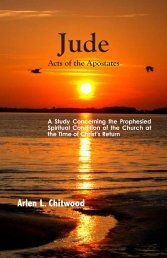Signs in John's Gospel - The Lamp Broadcast
Signs in John's Gospel - The Lamp Broadcast
Signs in John's Gospel - The Lamp Broadcast
Create successful ePaper yourself
Turn your PDF publications into a flip-book with our unique Google optimized e-Paper software.
Two Days <strong>in</strong> Samaria, <strong>The</strong>n… 129<br />
were still offere<strong>in</strong>g Paschal sacrifices among the temple ru<strong>in</strong>s, <strong>in</strong><br />
keep<strong>in</strong>g with that stated <strong>in</strong> Exodus chapter twelve (someth<strong>in</strong>g<br />
which cont<strong>in</strong>ued down through the succeed<strong>in</strong>g centuries and still<br />
exists dur<strong>in</strong>g modern times [i.e., Samaritan priests today, over<br />
two millenniums after the destruction of their temple, still offer<br />
sacrifices among the temple ru<strong>in</strong>s on Mount Gerizim]).<br />
<strong>The</strong> Samaritans built their temple on Mount Gerizim because<br />
they believed that this was the place which God had chosen (Deut.<br />
12:5-14), rather than Jerusalem. And this could only have been<br />
based on a history of the Israelites as it perta<strong>in</strong>ed to two mounta<strong>in</strong>s<br />
— Mount Gerizim and Mount Ebal.<br />
<strong>The</strong>se two mounta<strong>in</strong>s were located next to one another, with a<br />
valley ly<strong>in</strong>g between (about 35 miles north of Jerusalem). Mount<br />
Gerizim lay to the south and Mount Ebal to the north, with both<br />
ris<strong>in</strong>g to an approximate 3,000-foot elevation. And Jesus’ discourse<br />
with the Samaritan woman occurred near these two mounta<strong>in</strong>s.<br />
<strong>The</strong>se were mounta<strong>in</strong>s which God had s<strong>in</strong>gled out over fourteen<br />
centuries earlier, dur<strong>in</strong>g Moses and Joshua’s day, when the<br />
Israelites were prepar<strong>in</strong>g to cross the Jordan River and enter the<br />
land. One mount (Gerizim) was to be associated with bless<strong>in</strong>gs,<br />
and the other mount (Ebal) was to be associated with curses.<br />
And that which the Israelites were commanded to perform<br />
on both Mount Gerizim and Mount Ebal once they had entered<br />
the land (Deut. 27:1-26; cf. Joshua 8:30-35), contextually (Deut.<br />
28), could only have been an object lesson for the Jewish people<br />
<strong>in</strong> the theocracy.<br />
Bless<strong>in</strong>gs would be realized if the people obeyed all that the<br />
Lord had commanded; curses, on the other hand, would befall the<br />
people if they did not obey all that the Lord had commanded.<br />
Note the twelve curses (a number signify<strong>in</strong>g governmental perfection)<br />
which the Levites were to speak before all the people <strong>in</strong> Mount<br />
Ebal (Deut. 27:14-26), <strong>in</strong>dicat<strong>in</strong>g that which would befall a disobedient<br />
people with<strong>in</strong> the theocracy (that which would befall those<br />
from the twelve tribes, aga<strong>in</strong> po<strong>in</strong>t<strong>in</strong>g to governmental perfection).<br />
<strong>The</strong>n, the follow<strong>in</strong>g chapter, chapter twenty-eight, relates both<br />
sides of the issue — bless<strong>in</strong>gs, associated with Mount Gerizim (vv.<br />
1-14); and curses, associated with Mount Ebal (vv. 15-68).



